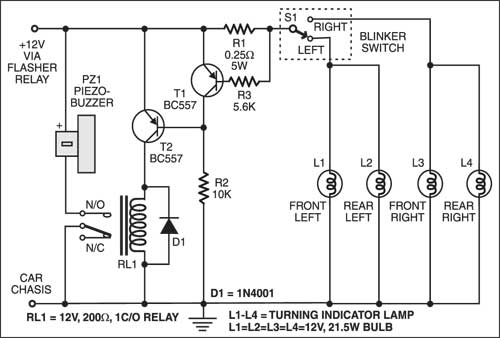 Before taking a turn, either left or right, car drivers need to switch on the car’s turn-indicator lamps so that the approaching vehicle drivers can take precaution accordingly. An accident is likely to occur in case your car’s turn-indicator lamps fail to glow due to some reason or the other. Here’s a car fault indicator alarm circuit that sounds an alarm if your turn indicator lamps doesn’t glow, helping you to safeguard against any accident.
Before taking a turn, either left or right, car drivers need to switch on the car’s turn-indicator lamps so that the approaching vehicle drivers can take precaution accordingly. An accident is likely to occur in case your car’s turn-indicator lamps fail to glow due to some reason or the other. Here’s a car fault indicator alarm circuit that sounds an alarm if your turn indicator lamps doesn’t glow, helping you to safeguard against any accident.
Car Fault Indicator Alarm Circuit
When both the the front and rear turn indicator lamps (either right or left) glow, the current through the lamps (L1-L2 or L3-L4) causes a voltage drop across series resistor R1. This voltage drives pnp transistor T1 into saturation. In this condition, pnp transistor T2 does not conduct and hence relay RL1 does not energise. No sound from piezobuzzer PZ1 (connected to normally-opened (N/O) contacts of relay RL1) means that the turn-indicator lamps are working satisfactorily.

When one or both of the turn-indicator bulbs are fused, the voltage drop across R1 is insufficient and pnp transistor T1 remains cut-off. In this condition, pnp transistor T2 conducts to energise relay RL1 and piezobuzzer PZ1 sounds to indicate that one or both the turn-indicator bulbs are fused.
Install the circuit (excluding turn-indicator lamps L1 through L4, which are already fitted in your car) near the driver’s seat so that the driver has easy access to blinker switch S1. To turn left, the driver needs to connect blinker switch S1 to left position to flash front and back left-turn-indicator lamps (L1 and L2). Similarly, to turn right, he needs to connect blinker switch S1 to right position to flash front and back right-turn indicator lamps (L3 and L4).
The value of resistor R1 is to be changed according to the bulb wattages.
The article was first published in August 2004 and has recently been updated.






